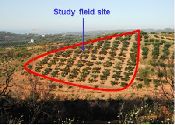| WOCAT mapping, GIS and the Góis municipality |
 |
|
T.C.J. Esteves (1), J.A.A. Soares (2), A.J.D. Ferreira (1), C.O.A. Coelho (2), M.A. Carreiras (1), and G.V. Lynden (3) (1) Department of Environment, IPC - Escola Superior Agrária de Coimbra, Coimbra, 3040-316, Portugal, (2) Department of Environment and Planning, Universidade de Aveiro, Aveiro, 3810-193, Portugal, (3) ISRIC - Wageningen University and Research Centre, NL-6701 AJ Wageningen, Netherlands
In the scope of the goals of the association “The World Overview of Conservation Approaches and Technologies” (WOCAT), the established methodology intends to support the sustainable development of new techniques and the process of decision making in Sustainable Soil Management (SSM). Its main goal is to promote the co-existence with nature, in order to assure the wellbeing of upcoming generations. SSM is defined as the use of terrestrial resources, including soil, water, fauna, flora, for the production of goods that fulfill human needs, guaranteeing simultaneously a long-term productive potential for these resources, as well as the maintenance of their environmental functions. The EU-funded DESIRE (Desertification Mitigation & Remediation of Land: a global approach for local solutions) project is centered on SSM, having as a main goal the development and study of promising conservation, soil use and management strategies, therefore contributing for the protection of arid and semi-arid vulnerable areas. In Portugal, one of the main soil degradation and desertification agents are wildfires. There is consequently an urgent need to establish integrated conservation measures to reduce or prevent these occurrences. To do so, and for the DESIRE project, theWOCAT methodology was implemented, where it could be foreseen as 3 major questionnaires for: technologies (WOCAT Technologies), approaches (WOCAT Approaches) and mapping (WOCAT Mapping).
The established methodology for WOCAT Mapping was created in order to attend the questions associated to the soil and water degradation, emphasizing the direct and socio-economic causes of this degradation. It evaluates what type of soil degradation is occurring, where, why and what actions are in practice in what respects to SSM. The association of this questionnaire to Geographical Information Systems (GIS) allows not only to produce maps, but also to calculate areas, taking into account several aspects of soil degradation and conservation. The map database and their outputs give a comprehensive and powerful tool to obtain a global vision of the degradation state of a given territory, at the desired local or regional scale.
However for the selected study area, the Portuguese Góis Municipality, there was no base information prepared to be readily inserted in the geographical database. It was necessary to create the requested mapping units, so that the WOCAT Mapping questionnaire could be used.As a result, municipal cartography with 39 mapping units was obtained, and for each one, an exhaustive field work was made, allowing to characterize them in detail and answer the required information by WOCAT Mapping. These answers allowed creating a clearer image of what is happening in the territory in what respects to the used techniques, degradation degree and conservation measures applied. The all-important contact with the municipalities main stakeholders is an important aspect to refer, once they are the ones to help validate the obtained results for theWOCAT Mapping methodology, due to their extensive knowledge of the territory.
|

Acknowledgement
The DESIRE project was
|
DESIRE brought together the expertise of
26 international research institutes
and non-governmental organisations.
This website does not necessarily
represent the opinion of the
European Commission. The European
Commission is not responsible for
any use that might be made of the
information contained herein. 
